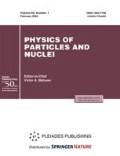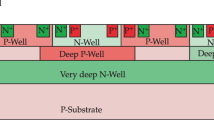Abstract—
Today, silicon-based detector systems are playing a key role in experimental studies of nuclear matter properties, as well as in high energy and particle physics. Using thin silicon pixel detectors for the precise identification of charged particles opens completely new opportunities to investigate the states of nuclear matter arising as a result of relativistic nuclear collisions. For stable operational conditions of such detectors, an optimal system for their positioning and support and an effective cooling system while maintaining a minimum material budget are required. In this work, the ideas and developments for support and cooling systems for novel vertex detectors based on silicon pixel sensors are presented.




Similar content being viewed by others
REFERENCES
B. Abelev et al. (ALICE Collab.), “Technical design report for the upgrade of the ALICE inner tracking system,” J. Phys. G 41, 087002 (2014).
L. Musa, Paper presented at the ECFA High Luminosity LHC Experiments Workshop, Aix-Les Bains, France, October 2016; ALICE Inner Tracking System Upgrade.
V. I. Zherebchevsky, I. G. Altsybeev, G. A. Feofilov, et al., “Experimental investigation of new ultra-lightweight support and cooling structures for the new inner tracking system of the ALICE detector,” J. Instrum. 13, T08003 (2018).
V. I. Zherebchevsky, S. N. Igolkin, E. B. Krymov, et al., “Extra lightweight mechanical support structures with the integrated cooling system for a new generation of vertex detectors,” Instrum. Exp. Tech. 57, 356–360 (2014).
V. I. Zherebchevsky, V. P. Kondratiev, V. V. Vechernin, and S. N. Igolkin, “The concept of the MPD vertex detector for the detection of rare events in Au + Au collisions at the NICA collider,” Nucl. Instrum. Methods Phys. Res., Sect. A 985, 164668 (2021).
L. Musa et al. (ALICE Collab.), “Letter of intent for an ALICE ITS upgrade in LS3,” ALICE-PUBLIC-2018-013, CERN-LHCC-2019-018/LHCC-I-034, CERN, Geneva, Switzerland, 2019.
Funding
This work was supported by the Russian Foundation for Basic Research, project no. 18-02-40075.
Author information
Authors and Affiliations
Corresponding author
Ethics declarations
The authors declare that they have no conflicts of interest.
Additional information
Translated by I. Obrezanova
Rights and permissions
About this article
Cite this article
Nesterov, D.G., Zherebchevsky, V.I., Feofilov, G.A. et al. Cooling Systems for the Novel Pixel Detectors. Phys. Part. Nuclei 53, 582–588 (2022). https://doi.org/10.1134/S1063779622020630
Received:
Revised:
Accepted:
Published:
Issue Date:
DOI: https://doi.org/10.1134/S1063779622020630




